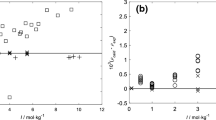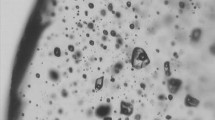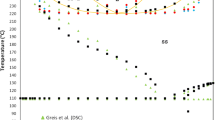Abstract
On the basis of Parry’s method (1986), an improved method was established to determine the molar volume (V m) and compositions (X) of the NaCl-H2O-CO2 (NHC) system inclusion. To use this method, the determination of V m-X only requires three microthermometric data of a NHC inclusion: partial homogenization temperature \((T_{h,CO_2 } )\), salinity (S) and total homogenization temperature (T h). Theoretically, four associated equations are needed containing four unknown parameters: \(X_{CO_2 } \), X NaCl, V m and F (volume fraction of CO2 phase in total inclusion when occurring partial homogenization). When they are released, the V m-X are determined. The former three equations, only correlated with \(T_{h,CO_2 } \), S and F, have simplified expressions:
The last one is the thermodynamic relationship of \(X_{CO_2 } \), X NaCl, V m and T h:
Since the above four associated equations are complicated, it is necessary to adopt iterative technique to release them. The technique can be described by: (i) Freely input a F value (0⩽F⩽1), with \(T_{h,CO_2 } \) and S, into the former three equations. As a result, \(X_{CO_2 } \), X NaCl and the molar volume value recorded as V m1 are derived. (ii) Input the \(X_{CO_2 } \) and X NaCl gotten in the step above into the last equation, and another molar volume value recorded as V m2 is determined. (iii) If V m1 is unequal to V m2, the calculation will be restarted from “(i)”. The iteration is completed until V m1 is equal to V m2, which means that the four associated equations are released. Compared to Parry’s (1986) solution method, the improved method is more convenient to use, as well as more accurate to determine \(X_{CO_2 } \). It is available for a NHC inlusion whose partial homogenization temperature is higher than clatherate melting temperature and there are no solid salt crystals in the inclusion at partial homogenization.
Similar content being viewed by others
References
Burke E A J. Raman microspectrometry of fluid inclusions. Lithos, 2001, 55: 139–158
Lu H Z, Fan H R, Ni P, et al. Fluid Inclusions (in Chinese). Beijing: Science Press, 2004. 1–487
Bakker R J, Diamond L W. Determination of the composition and molar volume of H2O-CO2 fluid inclusions by microthermometry. Lithos, 2000, 64: 1753–1764
Bakker R J, Dubessy J, Cathelineau M. Improvements in clathrate modeling: 1. The H2O-CO2 system with various salts. Geochim Cosmochim Acta, 1996, 60: 1657–1681
Bakker R J. CLATHRATES: Computer programs to calculate fluid inclusion: V-X properties using clathrate melting temperatures. Comput Geosci, 1997, 23: 1–18
Bakker, R. J., Package FLUIDS, 1. Computer programs for analysis of fluid inclusion data and for modeling bulk fluid properties. Chem Geol, 2003, 194: 3–23
Brown P E, Hagemann S G. MacFlinCor and its application to fluids in Archean lode-gold deposits. Geochim Cosmochim Acta, 1995, 59: 3943–3952
Chang Z S. Volume measurement of individual phases in an inclusion: present status and advances, Adv Earth Sci (in Chinese), 1995, 10: 554–561
Schwartz M Z. Determining phase volumes of mixed CO2-H2O inclusions using microthermometric measurements. Mineral Dep, 1989, 24: 43–47
Parry W T. Estimation of \(X_{CO_2 } \), P and fluid inclusion volume from fluid inclusion temperature measurements in the system NaCl-H2O-CO2, Econ Geol, 1986, 81: 1009–1013
Bowers T S, Helgeson H C. Calculation of the thermodynamic and geochemical consequences of nonideal mixing in the systems H2O-CO2-NaCl on phase relations in geologic systems: Equation of state for H2O-CO2-NaCl fluids at high pressures and temperatures. Geochim Cosmochim Acta, 1983, 47: 1247–1275
Bodnar R J. A method of calculating fluid inclusion volumes based on vapor bubble diameters and P-V-T-X properties in inclusion fluids. Econ Geol, 1983, 78: 535–542
Sterner S M, Bondar R J. Synthetic fluid inclusions, X: experimental determination of P-V-T-X properties in the CO2-H2O system to 6 kb and 700°C. Am Sci, 1991, 291: 1–54
Diamond L W, Akinfiev N N. Solubility of CO2 in water from 1.5 to 100°C and from 0.1 to 100 MPa: Evaluation of literature data and thermodynamic modeling. Fluid Phase Equilibria, 2003, 208: 265–290.
Potter R W, Brown D L. The volumetric properties of aqueous sodium chloride solutions from 0°C to 500°C at pressure up to 2000 bars based on a regression of available data in the literature, U. S. Geol Sur Bull, 1977, 1421-C: 1–36
Diamond L W. Systematics of H2O fluid inclusions, Fluid Inclusions: Analysis and Interpretation (eds. Samson I Anderson A, Marshall D). Canada: Mineralogical Association of Canada Short Course Series, 2003, 32: 81–100
Duan Z, Moller N L, Weare J H. Equation of state for the H2O-CO2-NaCl system: Prediction of phase equilibria and volumetric properties. Geochim Cosmochim Acta, 1995, 59: 2869–2882
Schmidt C, Bodnar R J. Synthetic fluid inclusions: XVI.PVTX properties in the system H2O-CO2-NaCl at elevated temperatures, pressures, and salinities. Geochim Cosmochim Acta, 2000, 64: 3853–3869
Roedder E. Fluids inclusions, Reviews in mineralogy. Mineral Soc Am, 1984, 12: 1–644
Angus S, Armstrong B, deReuck K M. Carbon Dioxide: International Thermodynamic Tables of The Fluids State, Oxford: Pergamon Press, 1976. 1–385
Author information
Authors and Affiliations
Corresponding author
Additional information
Supported by the State Key Development Program for Basic Research of China (Grant No. 2004CB720503)
Rights and permissions
About this article
Cite this article
Song, Y., Hu, W., Ni, P. et al. Improved method to determine the molar volume and compositions of the NaCl-H2O-CO2 system inclusion. SCI CHINA SER D 50, 385–391 (2007). https://doi.org/10.1007/s11430-007-2074-5
Received:
Accepted:
Issue Date:
DOI: https://doi.org/10.1007/s11430-007-2074-5




